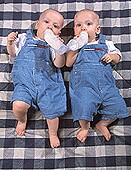
FRIDAY, July 25, 2014 (HealthDay News) — Twins’ genes may play a greater role in language delay than their environment, according to a new study.
Researchers found more evidence that language traits, such as vocabulary, putting words together and grammar, were largely inherited.
The study involving 473 sets of twins revealed that the “twinning effect” (a lower level of language performance for twins than single-born children) was greater for identical twins than non-identical twins.
“This finding disputes hypotheses that attribute delays in early language acquisition of twins to mothers whose attention is reduced due to the demands of caring for two toddlers,” explained the study author Mabel Rice, a University of Kansas distinguished professor. “This should reassure busy parents who worry about giving sufficient individual attention to each child.”
The twins involved in the study were followed from birth until 2 years old. They were also compared to single-born children. None of the children had a disability that would affect their language development.
Language delay means children are not using the number of words or combining two or more words into sentences in a way that is expected for their age and gender.
Besides vocabulary, the researchers also took children’s early grammatical skills into account, such as their use of the past tense and the “to be” and “to do” verbs.
After two years, 47 percent of the identical twins and 31 percent of the non-identical twins had language delays.
The researchers also found that 71 percent of the twins were not combining words by age 2, compared to 17 percent of the single-born children.
Overall, the twins had double the rate of language delay compared to the single-born children, according to the study, published in the June issue of the Journal of Speech, Language, and Hearing Research.
With funding from the National Institute for Deafness and Other Communication Disorders, the study authors will continue to follow the twins until at least 2017. By examining their performance from preschool through elementary school, they plan to determine if “late talkers” eventually catch up to other kids their age who did not have a language delay.
In addition to language tests, the researchers collected genetic and environmental data on the twins. They also assessed the twins’ brothers and sisters.
“Twin studies provide unique opportunities to study inherited and environmental contributions to language acquisition,” said Rice. “The outcomes inform our understanding of how these influences contribute to language acquisition in single-born children, as well.”
Although genetics accounted for roughly 43 percent of the overall twins’ deficit, the researchers said premature birth and delivery complications — sometimes associated with language delay — are more common among identical twins.
While the study showed an association between having an identical twin and greater language delays, the study was not designed to prove cause-and-effect.
More information
The American Speech-Language Hearing Association provides more on language delay.
Copyright © 2025 HealthDay. All rights reserved.

